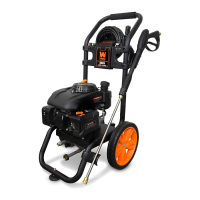DRAINING THE SOAP (FIG. 17)
To drain the soap, unplug the hose highlighted in Figure 17
(Fig. 17 - 1). Use a container to hold the draining soap. Once
the soap is done draining, reconnect the hose.
SPARK PLUG MAINTENANCE
The spark plug is important for proper engine operation.
A good spark plug should be intact, free of deposits, and
properly gapped. Refer to Recommended Maintenance
Schedule.
TO INSPECT THE SPARK PLUG (FIG. 18 & 19):
1. Remove spark plug boot (Fig. 18 - 1). Be careful not to
tear insulation or wiring.
2. Unscrew the spark plug from the engine using a spark
plug wrench. There is limited space for the wrench to turn.
Use both rows of holes in the spark plug wrench to gain
leverage to loosen the plug.
3. Visually inspect the spark plug for cracks or excessive
electrode wear. Replace as necessary.
4. Measure the plug gap with a wire gauge. The gap should
be 0.7-0.8 mm (0.028-0.031 in). (Fig. 19)
5. If re-using the spark plug, use a wire brush to clean any
dirt from around the spark plug base then re-gap the spark
plug.
6. Screw the spark plug back into the spark plug hole using
the spark plug wrench. Do not over-tighten spark plug.
Recommended tightening of spark plug is ½ to ¾ of a turn
after the spark plug gasket contacts the spark plug hole, or
20 ft-lb. Reinstall the spark plug boot.
Fig. 17
1
Fig. 18
1
Fig. 19
0.7 - 0.8 mm
MAINTENANCE
3. Unscrew the carburetor drain plug to drain the carburetor (Fig. 20). Be sure to drain the carburetor
so the machine can funtion properly for the next use.
4. Re-attach the fuel line to the exposed end of carburetor.
CAUTION: Do not dispose of the fuel in general waste. Make sure to collect it and take the fuel to your
local recycling center. Do not store fuel for more than 3 months.
19

